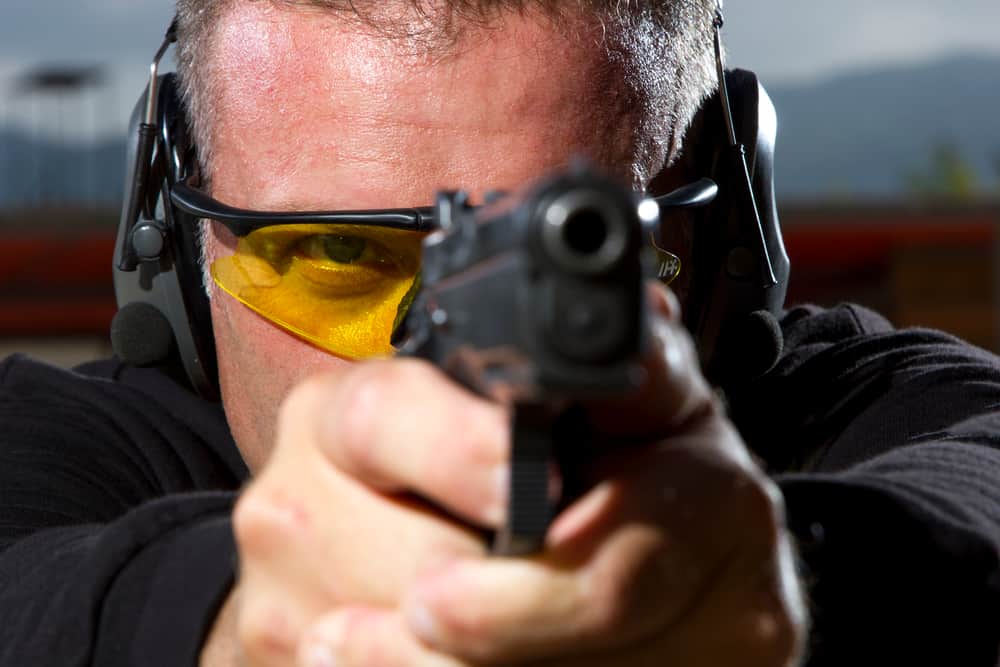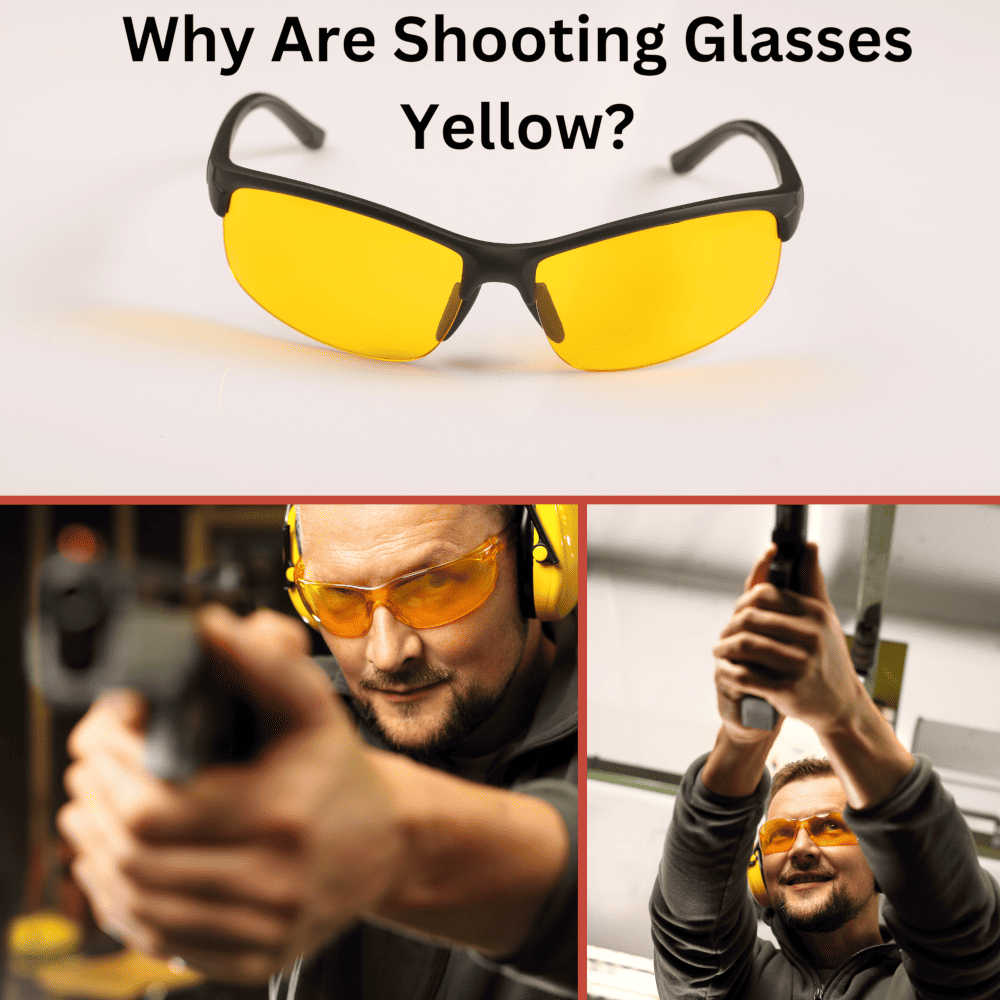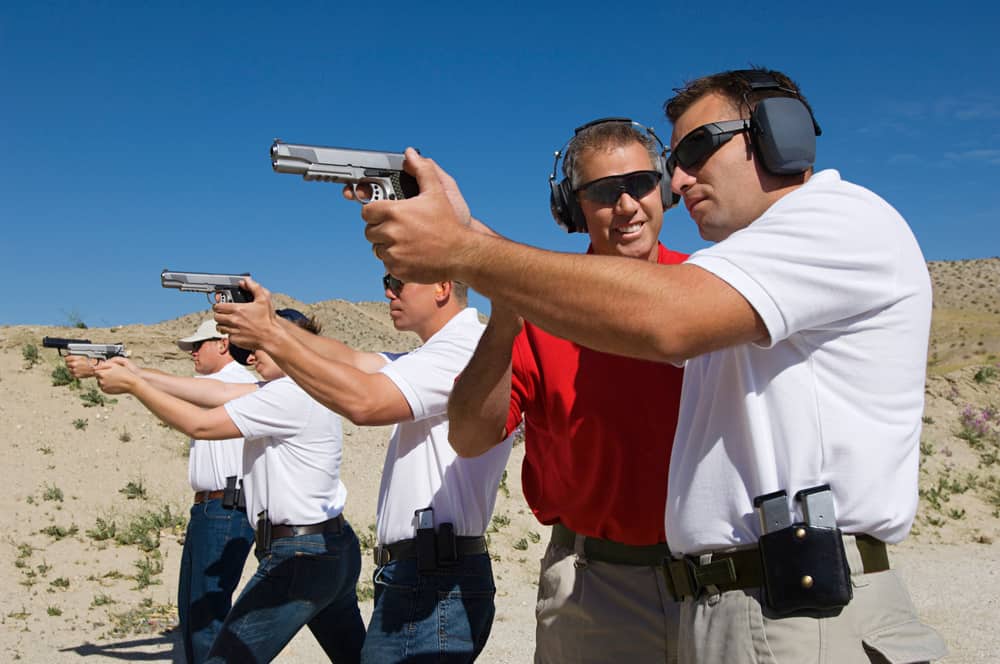Between my day job and the email inquiries off this site, I am asked several questions about shooting glasses daily. Interestingly enough, the most common question or questions that I’m asked are focused on the why wear eye protection when shooting question or the do I really need to shoot glasses at the range question.
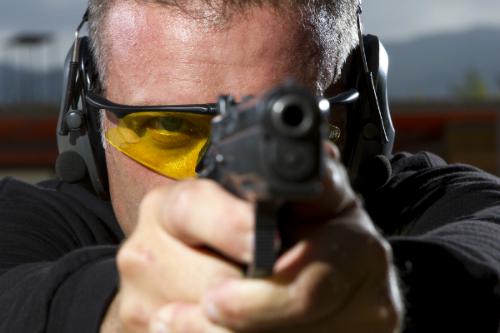
While the questions are phrased in several different ways and approaches, the result is really the same: shooters and hunters questioning the real need to wear eye protection. In many cases, the questions are phrased, so I’m often tasked with trying to convince or justify the absolute need for shooting glasses.
Here are a few examples that I’ve been asked over the years:
- Why do you need shooting glasses?
- Do I really need shooting glasses?
- Why wear shooting glasses?
- Do you need eye protection when shooting?
- Why wear safety glasses when shooting?
- I wear glasses, so do I need safety glasses when shooting?
I could provide more examples, but I think you get the idea.
Given the number of times, this question is asked, I thought it might make sense to put an answer down on paper.
Before I dive right into answering the question, let me provide some background details that describe my transition from a “who really needs shooting glasses” attitude over to a card-carrying advocate of eye protection in general for nearly every situation.
I grew up in rural North Carolina, where outdoor sports were basically part of the lifestyle. Nearly everyone I grew up with was a hunter, fisherman, or outdoorsman to some degree.
Like most kids, I started with a BB gun when I was 8 or 9 and worked my way up to a 22 rifle, shotgun, and then on to a centerfire rifle.
Along that path, I actively hunted most of the hunting species popular in the area: dove, quail, squirrel, rabbit, and deer. I also did a little skeet and trap shooting as well.
During that time, hardly anyone, including the adults that I hunted or shot with, ever used any type of shooting glasses or eye protection. It just wasn’t something that was expected back in those days.
To be fair, I’d already had a few close calls with a BB gun or pellet rifle, where a BB ricocheted off something and hit me in the face, but it was never enough to make me adopt safety glasses.
Fast forward to my early 20’s when I entered law enforcement. In the controlled environment of law enforcement, protective eyewear at the range was a requirement, and that was my first experience with protective eyewear.
However, this is also where my first significant (at least, significant for me) eye injury occurred. At that time, I was a big fan of the Ray-Ban Aviator style of sunglasses with the wrap-around ear stems. During a pistol and shotgun qualification session, I opted to wear those sunglasses instead of the department- provided shooting glasses. Keep in mind that style of sunglasses did not offer complete wrap-around coverage for the eyes as they had
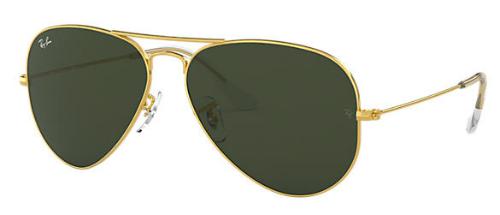
My department carried semi-automatic 9mm handguns back then, and that particular session was crowded, so more officers than usual were lined up in the open shooting lanes. As the officer to my immediate left was shooting, a spent 9mm casing ejected from his handgun came in through the slight opening on the left side of my sunglasses. It struck the inside lens of my sunglasses and then ricocheted into my eye.
While I was accustomed to seeing flying brass in my peripheral vision, I never thought in a million years that the opening in the glasses was enough to let a piece of flying brass through.
The spent brass shell covered in power residue didn’t go directly into my eye but hit at an angle. I felt less of the impact but more of a burning pain, and I was immediately unable to reopen my left eye, even though I tried. I suspect that’s a reflex action as it’s the eye’s way of dealing with pain.
I immediately went to the first aid area, where I had to manually force open my eye while another officer tried to flush the eye out with water. While I didn’t see any blood, I knew that something was wrong as, in addition to the pain, the vision in my left eye was blurry and out of focus.
After a 25 minute ride to the local hospital, I had to wait another 30 minutes for the on-call ophthalmologist to arrive. I was diagnosed with a severely scratched cornea (I believe the official term was a “Corneal Abrasion”), and the Doctor had to manually remove some debris removed that was still embedded in my eye.
Luckily, there was no permanent damage, but I ended up wearing an eye patch for two weeks and two weeks of light-duty. The department also changed its range policy, so all officers had to wear/use department provided shooting or safety glasses.
The worst part for me was that all that could have easily been avoided if I had just worn the department’s safety glasses.
In all honestly, that incident scared the crap out of me and converted me over to an advocate of eye protection. Today, I don’t shoot anything, rifle, shotgun, or pistol, without proper eye protection. Heck, I also started wearing eye protection when cutting the grass, running a weedeater, chainsaw, etc.
Why Wear Shooting Glasses
Let’s get back on the main topic here of why you need to wear shooting glasses. Here’s a quick list of reasons, then we’ll get into a more in-depth discussion of each topic below:
- Protection from flying projectiles
- Protection from flying particles like powder
- Protection from the elements like wind, sun, dust, etc.
Let’s discuss each of these topics more in-depth:
Protection from Flying Projectiles
Out of all these reasons I’ve mentioned, this one is probably the primary focus of shooting glasses and the one that most people first think of when you discussed shooting related eye protection.
For most people reading this article, the word “projectile” will bring to mind an actual round fired from a rifle, pistol, or shotgun, but the actual application is far more in-depth.
With shooting glasses, you are potentially talking about bullets, rounds, or pellets fired from a powder operated firearm, but you can’t forget about secondary types of projectiles like:
- BB’s
- Pellets
- Airsoft rounds
- Paintball rounds
While it may sound far-fetched, statistically speaking, there are far more shooting related eye injuries each year due to BB and pellet gun incidents than traditional powder-based firearms. And I’ll get into statistics and sources later in this article.
Another big culprit in eye injuries within the traditional firearms segment (which does not include air or C02 powered guns) involves a ricochet. This occurs when the bullet, round, pellet, slug, etc., strikes an object at an angle and bounces off that object in a new or the same direction.
Ricochets can also occur when the projectile (bullet, pellet, etc.) hits a hard object and breaks into pieces as it bounces off the hard item.
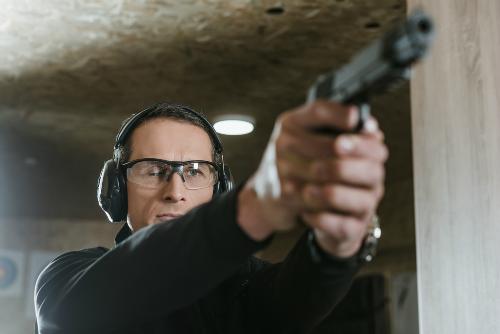
I was once shooting a 9mm handgun at a steel target at a safe distance and had a piece of a round ricochet back and hit my foot. Luckily, I was wearing boots (due to cold weather), and the ricochet particle actually hit with enough force to lodge into the boot. I have a picture of that somewhere, and I’ll do my best to find and include it in this write-up.
If you don’t take anything else away from this content, I’m hoping that protecting the eye from a projectile is enough to stick with you.
Protection from flying particles
Typically, with traditional firearms, the main culprit for flying particles is powder and other reloading components that are ejected from the firearm as the round is fired. This is generally more of a concern with handguns as the muzzle and action are closer to one’s face. However, it can also be a potential issue with semi-automatic rifles and shotguns where the ejection port or action port is near the face when shooting.
Most powder burns up as the round is fired, but, occasionally, there can be situations where not all the grains of powder burn, and they can be ejected around the shooter.
Although this issue isn’t potentially as big a concern as flying projectiles, it’s still a potential concern as who wants particles of gun powder in their eye?
Protection from elements like sun, wind, etc.
I’ve somewhat already discussed the importance of protecting your eyes from the ultraviolet rays of the sun in this article, so there’s no sense repeating it here.
In addition to UV rays, you also need eye protection from other elements like wind, rain, sleet, or snow.
Obviously, if you primarily shoot at an indoor range, then outdoor elements don’t really apply. Although, I have shot at a few indoor ranges where the air filtration system does cause some noticeable wind to keep the air moving through the filter system.
For me, in addition to sunlight, the wind is the other significant outdoor element that causes me the biggest issues in terms of eye protection. The wind picks up dirt, dust, and other particle-based debris, which can easily be blown into your eye.
But Aren’t Shooting Related Eye Injuries Rare?
That’s part of the logical argument and push-back I get (both in the store at my day job and online), but the actual statistics might surprise you:
Each year, emergency rooms see 30,000 eye injuries. Of those 30,000 cases, baseball was the #1 cause of that injury type, softball was #2, and eye injuries from an air gun were #3. Now, granted, this study is a bit dated as it is from 2016, but the results speak for themselves. Source: https://jamanetwork.com/journals/jamaophthalmology/fullarticle/2578714
According to a seven-year study of eye-related injuries from the United States Eye Injury Registry, 88% of shooted related eye injuries occur in males, and the highest number of incidents (about 72%) occur at home. With shooting related eye injuries, air gun powered incidents accounted for 68%, and powder-based firearms accounted for the remaining 32% of that injury group. Note that this data is a bit dated as well and is strictly based on ER visits. Source: https://www.healio.com/news/ophthalmology/20120225/firearms-a-frequent-source-of-ocular-injuries-worldwide-surgeon-says
A 2018 study from the Center for Injury Research and Policy of the Research Institute at Nationwide Children’s Hospital reports that data recorded from 1990 to 2012 shows a 169% in pediatric related eye injuries associated with non-powder based firearms. This group includes BB guns, pellet guns, airsoft guns, paintball guns, C02 powered guns, etc.) Source: https://www.sciencedaily.com/releases/2018/01/180108090241.htm
I could list some more, but I suspect you get the point.
The key takeaways from this info:
- Shooting related eye injuries can and do happen more than most people probably suspect.
- If you have a child or teenager who shoots any type of or participates in events involving any air-powered guns, then make absolutely sure they have and wear appropriate eye protection. And in case you missed my story above, sunglasses do not count.
- While protection from flying projectiles is the main focus of shooting glasses, they also offer the secondary benefits of protection from UV rays and protection from the wind.
- Although I’ve already mentioned it a few times, it’s worth repeating: regular sunglasses are certainly better than no protection at all, but they do not offer the same level of protection as impact resistant shooting glasses.
Here are some commonly asked questions that are also associated with the “why were shooting glasses” topic:
If I wear glasses, do I need safety glasses when shooting? (I wish a had a dollar for every time this question was asked)
Prescription glasses are better than having no eye protection at all when shooting, but RX glasses are not built to withstand the impact of a high-speed projectile. As such, they will most likely shatter or break into pieces.
Again, regular glasses do offer some level of eye protection, but they don’t provide the same level of protection supplied by shooting glasses or safety glasses.
What shooting glasses does the military use?
I assume that this question is directed towards the US military, and the answer is several different brands and models. The top military brand is usually a company called Eye Safety Systems (or ESS for short).
ESS provides several different military branches and units with specialized eye protection. In addition to providing the basic shooting glasses system for several branches (especially the Army), ESS also outfits many Navy units with specialized safety goggles for use on aircraft decks.
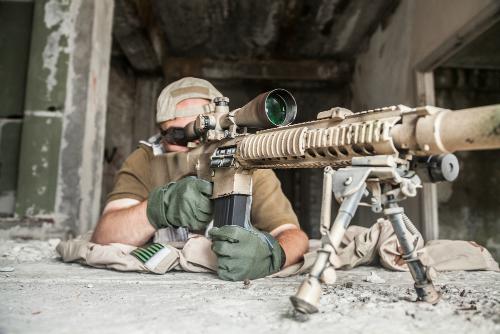
Keep in mind that they are other eye protection brands as well that are used in the military, such as Oakley, Revision, and Wiley-X. All brands and models approved for US military use are listed under the Authorized Protective Eyelist (APEL), which is updated annually. Here’s a link to the 2019 APEL list as an example. (https://www.med.navy.mil/sites/nostra/PP_CombatEyeProtection/APEL%20Poster%202019_FINAL.pdf)
Why wear safety glasses when shooting when they aren’t bulletproof?
You are absolutely correct that even the strongest or best-made shooting glasses or safety glasses are not bulletproof and most likely won’t stop or deflect a pistol or rifle round. Short of a ceramic helmet reinforced with Kevlar, not much is going to stop that round. Depending on the caliber, even a ceramic safety helmet may not be enough.
While that fact is entirely accurate, shooting glasses, at a minimum, will offer, at least, some form of protection in that scenario.
While they are not bulletproof, eye protection will protect your eyes from other types of potential damage that was listed above.

